- Who were prominent OBC kings of India? Political parties woo OBCs but who is an OBC? British role in creating caste differences.
For years media and politicians spoke
about scheduled castes, scheduled tribes and minorities. While they continue to
do so, the new kid on the block is Other Backward Classes or OBC. Chapter 18 verse
41 of Holy Gita refers to four varnas i.e. Brahmin,
Kshatriya, Vaishnav and Sudra. So OBC!
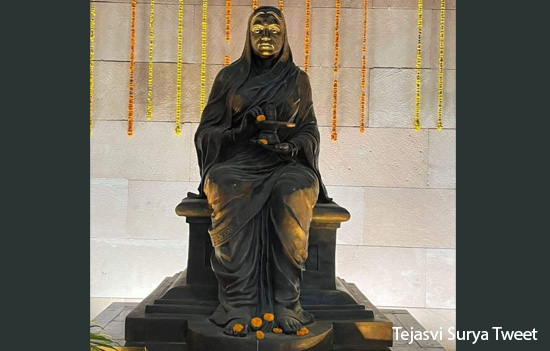 Ahilyabai Holkar built the Kashi Vishwanath Mandir & Vishnupad Temple in Gaya.
Ahilyabai Holkar built the Kashi Vishwanath Mandir & Vishnupad Temple in Gaya.
Continuous references to OBC in the
media compelled me to compile list of OBC (Other Backward Classes) Kings. It was
difficult because OBC nomenclature did not exist then. In case of errors write
back, to add to list write in with references.
Read Who
are Scheduled Tribes
Here are names of some OBC kings of Tamil Nadu, Maharashtra, Central India and Uttar Pradesh.
Tamil
Nadu
1. Rajaraja 1 (985 to 1014)
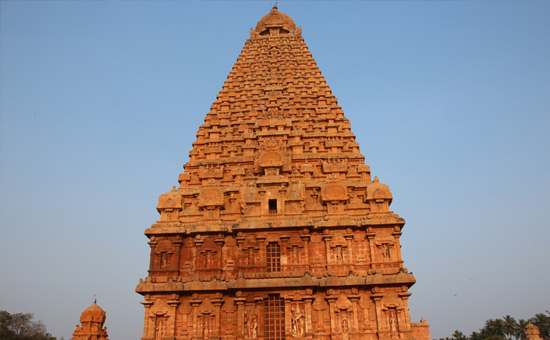 Big Temple Thanjavur was made by Rajaraja 1.
Big Temple Thanjavur was made by Rajaraja 1.An online search revealed Cholas belong
to Muthariyara koli caste. According to a list of Backward Classes released by the
state government Mutharaiyar (sr no 81) is included.
In Maharashtra, Koli caste
are typically the fisher community and shown as OBC. Tanaji (battle of
Sinhagadh) belonged to the Koli community.
2. His son Rajendra Chola
(1012 to 1044)
Dr D Ravikumar wrote, “According to Anandarangap Pillai’s diary, during the 18th century CE, the right-hand castes, including the Pariahs, held high societal status. The Valangai-Idangai caste system, which was a horizontal caste system in contrast to the vertical caste system, had kept castes organised in Tamil Nadu from the Chola period until the 18th century. However, it suddenly disappeared in the 19th century, and numerous castes emerged rapidly.” New Indian
Express
3. The King of Ramnad, Baskara Sethupathi (means protector
of the bridge), who sponsored Swami Vivekananda's trip to Chicago. He belongs to the Dakhini Hindu Maravar community.
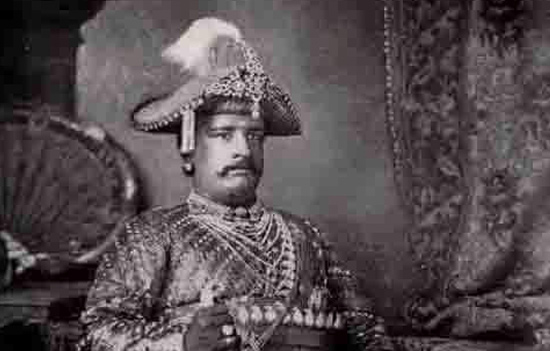 King of Ramnad.
King of Ramnad.
4.
Sundara Pandya (Pandyan
King) who gold plated the Tirupati temple.
If present day Kallar, Mravar and Agamudaiyar are
considered as descendants of the Pandyas, they are OBC as per the Central List
of OBCs for Tamil Nadu.
Maharashtra
1. Subedar Malharrao and Ahilyabai Holkar belonged to the Dhangar or Shepherd community. They are treated as OBC today but the community wants to be declared a Scheduled Tribe.
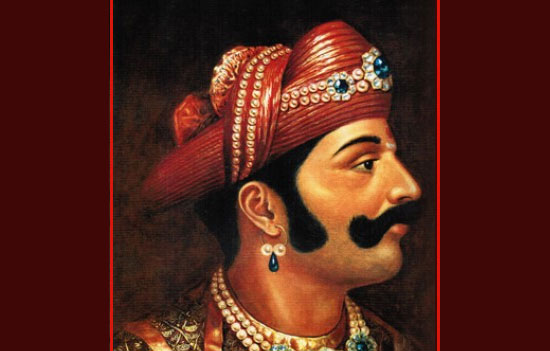 Malharrao Holkar.
Malharrao Holkar.
2. Gaikwads, the erstwhile rulers of Baroda - The surname means, “the one who
opened the gate to save the holy cow.” Mrinal Ambedkar in an article ‘The Sudras
rulers of India’ wrote, “founder Pilajirao Gaekwad was married to a lower caste women and Sayaji’s family descended from the child of that marriage.”
Gaikwad surname means
one can be Maratha or Scheduled Caste.
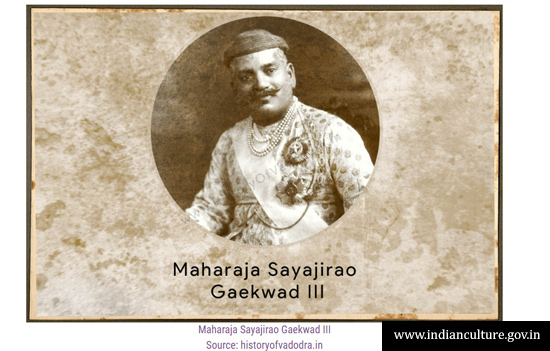 Sayajirao Gaekwad III.
Sayajirao Gaekwad III.
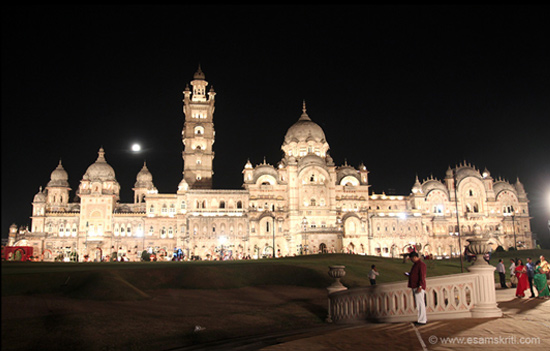 Lakshmi Vilas Palace Baroda is the current residence of the Gaikwads.
Lakshmi Vilas Palace Baroda is the current residence of the Gaikwads.
Read about Sayajirao
Gaekwad
Who can forget the most famous Gaekwad in contemporary India, Rajnikant or Shivajirao Gaekwad. This site says he is a Kshatriya Maratha / Mahar.
Col Anil Athale wrote in The Legacy of Shivaji the Great, “MAHARS played role of village guards and so found easy acceptance in Shivaji army. They manned the intelligence gathering and communication and were called HARKARAY.” Read How
Rajnikant may become a new emblem of Dalit assertion
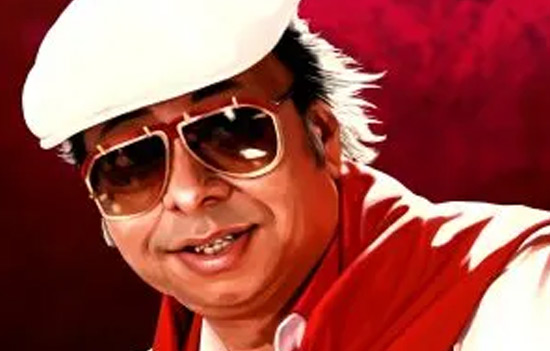 The super duper music director R D Burman was a ST.
The super duper music director R D Burman was a ST.
Honestly, it is their skills that matter, not caste. Same way, did you know that ace music-director R D Burman belonged to the Scheduled Tribe (Tripura).
3. Scindias or Shindes-got
conflicting information. One says they are 96 Kuli Marathas. Another says they
are OBC.
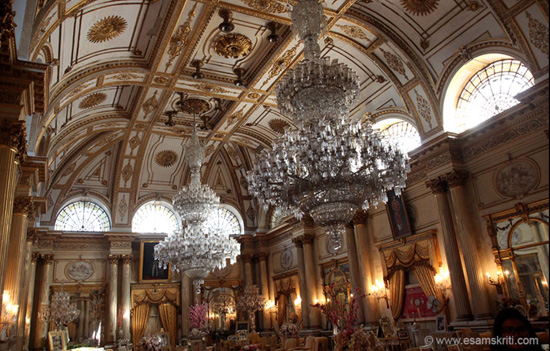 Durbar Hall, Jai Vilas Palace, Gwalior. It is a Shinde Palace.
Durbar Hall, Jai Vilas Palace, Gwalior. It is a Shinde Palace.
4. Kanhoji Angre - Maratha Naval Chief
Maratha navy in charge the brave Kanhoji Angre (1669-1729)was a Sankalp from Pune, means Dalit according to book Kulabakar Angrey by Daboo, a book on the history of the Angres sponsored by the Angre family. But the word Dalit never existed in the 17th century, is a post 1990 construct. Just like the word Scheduled Caste was introduced in the Government of India Act 1935 by the British.
5. Adivasi king Yashwantrao Martandrao Mukne of Jawhar Dahanu, near Mumbai
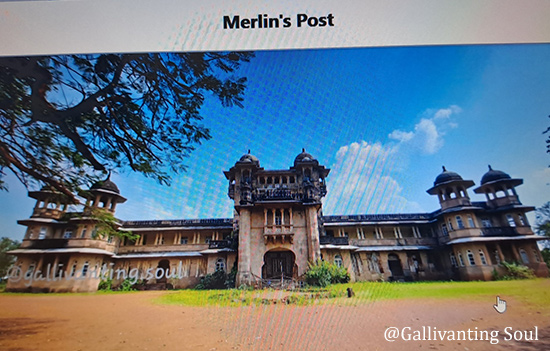 Jai Vilas Palace Jawhar Dahanu near Mumbai, owned by a Vanvasi king.
Jai Vilas Palace Jawhar Dahanu near Mumbai, owned by a Vanvasi king.Picture is
courtesy Merlin L Miranda thanks to her
FB post. Palace is built on top of a hill amidst cashew plantations. Manish
R Karnik wrote, this palace was built by Maharaj Yashwantrao Martandrao Mukne.
It is a lot more complex. Dhaval Kulkarni wrote in India Today, “Writer and activist Sanjay Sonwani notes that during caste censuses in British India, many castes claimed to belong to a more elite social group for upward mobility. For instance, the Kolis in Ahmednagar district claimed to be Kunbis. Similarly, the Dhangars in Baramati and Malegaon in Pune claimed to be Sagar Rajputs. Their caste panchayats had even passed resolutions on this. “They had sought the status of a more privileged caste for social upliftment,” explains Sonwani. “Now, a reverse process is under way where the rush is to belong to a caste lower down in the social order for quota benefits.”
Karnataka - Wodeyars, former rulers of Mysuru
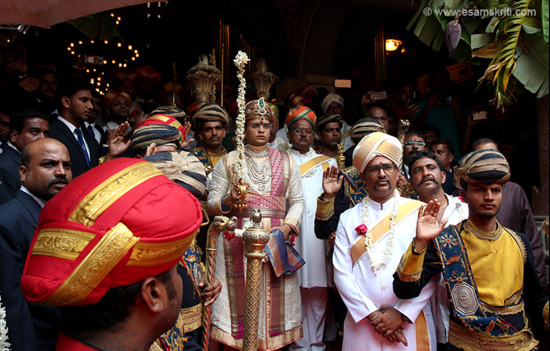 Mysore Dussehra 2018.
Mysore Dussehra 2018.
According to this Deccan Herald 2012
report the state government included the Urs/Arasu community (to which the former rulers belong) as OBC under category 2A of the backward classes list. I must add that not been able to find online the Urs community in the state government list although every resident Kannadiga I checked with said they are OBC.
Rajasthan – Gurjars
1. The
daughter-in-law of Vasundararaje Scindia (of the Royal family of Gwalior) is a Gurjar. Today, the Gurjar community
considered OBC, wish to be included as ST.
The
Gurjar-Pratihara dynasty produced a number of great kings. Forget the current
controversy on whether Mihir Bhoja was a Rajput or Gurjar- a perfect example of how caste divides and creates tensions between Hindus. He was Bharatiya period.
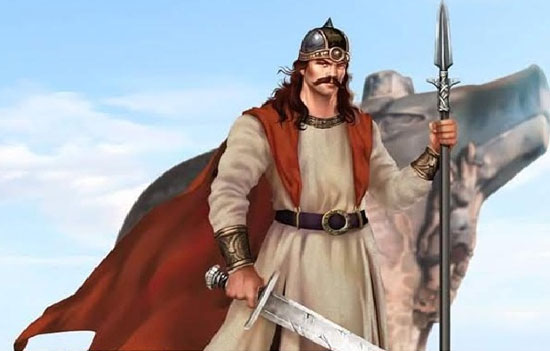 Raja Mihir Bhoja.
Raja Mihir Bhoja.
The key Gurjar-Pratihara
kings were Nagabhata I
(730-756), Vatsaraja, Nagabhata II, Mihir Bhoja, Mahendrapala. Below are excerpts
from an article that is based on Volume 4 of The History and Culture of Indian People published by Bharatiya Vidya Bhawan. Read About
Gurjara-Pratihara Empire
“Kulapati K M Munshi wrote that, “Under the Pratihaas, Kanauj reached the zenith of power, (815-940). Its rulers were called Gujaresvaras; in a later inscription, Gurjara-Pratiharas.” Kanauj or Kanyakubja continued to be the most influential centre of culture till 1018 A.D. when it was dethroned by Mahmud of Ghazni. Pg. x
Vatsaraja is said to have expanded his
kingdom in the North and defeated the Lord of Gauda, perhaps the king of
Bengal. The Jain Temple at Osian near Jodhpur was made by Vatsaraja in 783.
On the whole it can be said that
Nagabhata II exercised his sway on the large part if not the whole of Rajputana
and Kathiawar Peninsula. In the east his sway extended up to Gwalior and
probably further east so as to include Kanauj and Kalanjara.
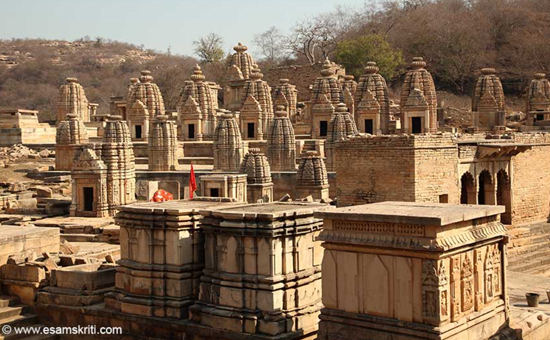 Bateshwar Temples, Morena near Gwalior were built by the Pratiharas.
Bateshwar Temples, Morena near Gwalior were built by the Pratiharas.
An Arab account of India composed in 851
and attributed to Sulaiman refers to the great power and resources of Mihir Bhoja.
Among the princes of India, there is no greater foe of the Muslim faith than
he.
Mahendrapala (885-908) maintained in tact his father’s empire and added Karnal district of modern day Haryana, Nepalese terrain and Rajshahi district of Bengal.” Pg xxii
To see albums of three monuments made by
Pratihara Kings.
1. Teli-ka-Mandir
Gwalior Fort
2. Bateshwar
Temples, Morena near Gwalior
3. Jain Mandir
Osian ie near Jaipur
Did such distinguished warriors and temple builders belong to backward classes-face marginalization!
Uttar Pradesh
Raja Suheldev
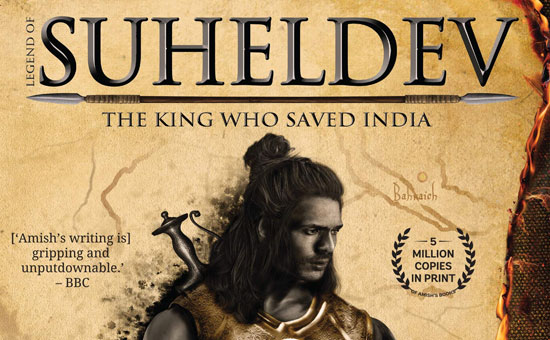
He defeated and killed the Ghaznavid
general Ghazi Salar Masud in the battle of Bahraich. This decisive defeat lead to a big pause in the Muslim conquest of
Bharatvarsh, none dared to invade from 1033 to 1187 A.D.
Today, Raja Suheldev is claimed by the
Rajbhars (OBC) and Pasi (SC). Read About Raja
Suheldev and the Battle of Bahraich
What matters are Raja Suheldev’s achievements not caste!
The British and political parties have accentuated and hard-coded caste such that Bharatiyas argue over the European word caste.
Did the above kings of
India suffer from any discrimination? Saying that the Legal
system played key role in addressing historical wrongs among marginalised
communities is a simplistic way of evaluating. Social backwardness is caused by multiple reasons just like members of the supposedly three forward castes could be socially backward too.
What people forget is that
their alleged marginalization could also be due to British and post 1947 government
policies!
When and why did caste
become rigid?
Briefly, “In the 10th century, the castes were comparatively fluid. But then the fundamental values of Dharmasastras were changed to provide defensive ramparts in order to present a solid front to an aggressive alien culture and religion.” History and
Culture of Indian People Volume 5 Post foreign invasions the caste
system became rigid.
Did the British have a hand in creating the caste system as we see it today?
In his book Castes of Mind Nicholas Dirks said rather than a basic expression of Indian tradition, caste is a modern phenomenon- the product of a concrete historical encounter between India and British colonial rule. He made a powerful case that the colonial past continues to haunt the Indian present. “The British produced conditions that made caste the central symbol of Indian society.” 4 Pg. 19
The British noted violence between left
and right hand caste in Tamil Nadu in 1790 over colour of flag to be used in
festivals. To avoid dispute British said only St George flag would be used.
Since temples were the centre of power then, they sought to control temples. How the British
took advantage of a complex caste system Times of India
Noted
Gandhian Dharampalji
wrote in Rediscovering
India, “For the British, as perhaps for some others before them, caste has been a great obstacle, in fact, an unmitigated evil not because the British believed in casteless-ness or subscribed to a non-hierarchical system but because it stood in the way of their breaking Indian society, hindered the process of atomisation, and made the task of conquest and governance more difficult.” Read Caste made into evil
J Sai Deepak
wrote in India that is Bharat, “But I am suggesting that it was under the British that ‘caste’ became a single term capable of expressing, organizing and above all ‘systematising India’s diverse forms of social identity, community and organization.” Pg. 304
Dr N Padmanabhan wrote in Caste and Social Stratification of Medieval
India (Calicut University), “The word ‘caste’ owes its origin to the Spanish word ‘casta’ which means ‘breed, race, strain or a complex of hereditary qualities’. The Portuguese applied this term to the classes of people in India known by the name of ‘jati’. The English word ‘caste’ is an adjustment of the original term.”
For the British caste
stood in the way of their breaking Indian society. For the rulers and people of
today it is about votes and reservations in government jobs/educational
institutions.
What is the definition of
Backward Classes?
Section 2 of the 1993 National Commission for Backward Classes Act defines “backward classes” as backward classes of citizens other than the Scheduled Castes and the Scheduled Tribes as may be specified by the Central Government in the lists.” Today it includes Muslim and Christian groups too, where caste is supposed to be non-existent.
When
did OBC become a vote-bank?
1990.
In August 1990, PM V P Singh said that the government
had accepted the Mandal Commission report that recommended 27% reservations for
OBC candidates at all levels of services.
Earlier, “In January 1953, the government had set up the First Backward Class Commission under the chairman of social reformer Kaka Kalelkar. The commission submitted its report in March 1955, listing 2,399 backward castes or communities, with 837 of them classified as ‘most backwards’. The report was never implemented.” Source
Different states
have classified OBC differently? It is assumed that their backwardness is due to caste and a centuries old phenomena.
How do experts assume that
all Brahmins, Kshatriyas, Vaishnavs face no marginalization and are well-off?
Do
people realize that continuous divisions of Bharatiya society are weakening it
and making it susceptible to undue external influence?
The solution is to make economic status the basis for government benefits. If an individual
has money the rest will fall in place.
Also
read
1. Congress strategy is to divide Hindus by caste
2. Shivaji’s karmas matter not caste
3.
OBC categories
and sub-categories
4. To
download Caste of Mind by Nicolas D
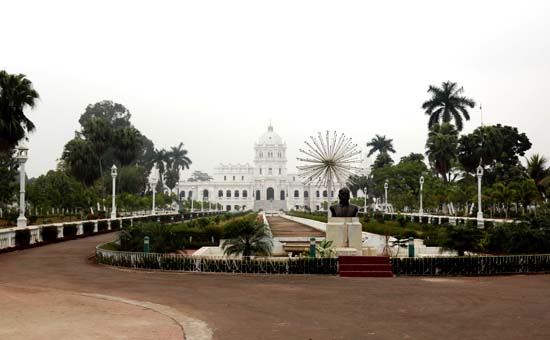 Palace of former Tripura Royal Family, now Scheduled Tribe. Note bust of Ambedkar at palace entrance.
Palace of former Tripura Royal Family, now Scheduled Tribe. Note bust of Ambedkar at palace entrance.